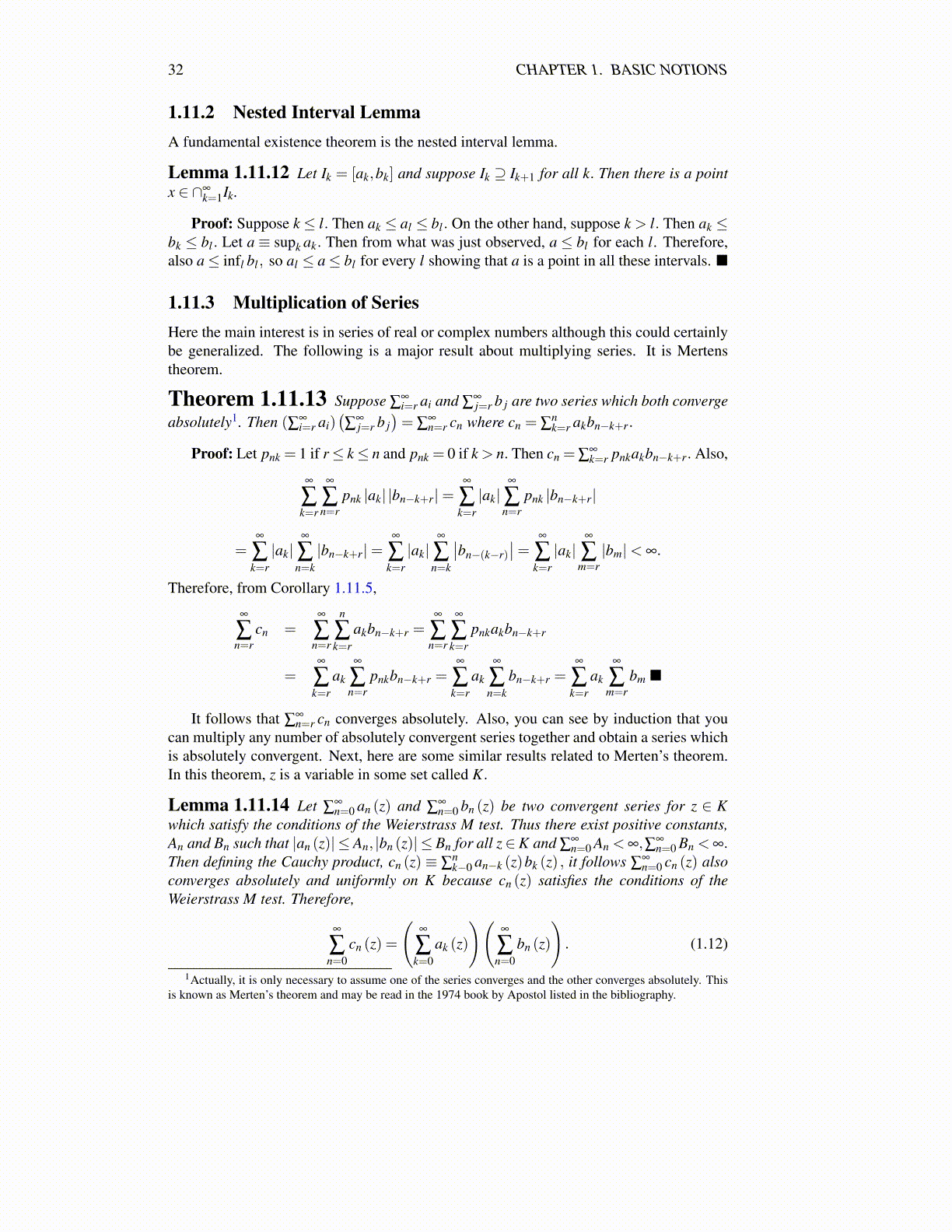
32 CHAPTER 1. BASIC NOTIONS
1.11.2 Nested Interval LemmaA fundamental existence theorem is the nested interval lemma.
Lemma 1.11.12 Let Ik = [ak,bk] and suppose Ik ⊇ Ik+1 for all k. Then there is a pointx ∈ ∩∞
k=1Ik.
Proof: Suppose k≤ l. Then ak ≤ al ≤ bl . On the other hand, suppose k > l. Then ak ≤bk ≤ bl . Let a ≡ supk ak. Then from what was just observed, a ≤ bl for each l. Therefore,also a≤ infl bl , so al ≤ a≤ bl for every l showing that a is a point in all these intervals. ■
1.11.3 Multiplication of SeriesHere the main interest is in series of real or complex numbers although this could certainlybe generalized. The following is a major result about multiplying series. It is Mertenstheorem.
Theorem 1.11.13 Suppose ∑∞i=r ai and ∑
∞j=r b j are two series which both converge
absolutely1. Then (∑∞i=r ai)
(∑
∞j=r b j
)= ∑
∞n=r cn where cn = ∑
nk=r akbn−k+r.
Proof: Let pnk = 1 if r≤ k≤ n and pnk = 0 if k > n. Then cn = ∑∞k=r pnkakbn−k+r. Also,
∞
∑k=r
∞
∑n=r
pnk |ak| |bn−k+r|=∞
∑k=r|ak|
∞
∑n=r
pnk |bn−k+r|
=∞
∑k=r|ak|
∞
∑n=k|bn−k+r|=
∞
∑k=r|ak|
∞
∑n=k
∣∣bn−(k−r)∣∣= ∞
∑k=r|ak|
∞
∑m=r|bm|< ∞.
Therefore, from Corollary 1.11.5,
∞
∑n=r
cn =∞
∑n=r
n
∑k=r
akbn−k+r =∞
∑n=r
∞
∑k=r
pnkakbn−k+r
=∞
∑k=r
ak
∞
∑n=r
pnkbn−k+r =∞
∑k=r
ak
∞
∑n=k
bn−k+r =∞
∑k=r
ak
∞
∑m=r
bm ■
It follows that ∑∞n=r cn converges absolutely. Also, you can see by induction that you
can multiply any number of absolutely convergent series together and obtain a series whichis absolutely convergent. Next, here are some similar results related to Merten’s theorem.In this theorem, z is a variable in some set called K.
Lemma 1.11.14 Let ∑∞n=0 an (z) and ∑
∞n=0 bn (z) be two convergent series for z ∈ K
which satisfy the conditions of the Weierstrass M test. Thus there exist positive constants,An and Bn such that |an (z)| ≤ An, |bn (z)| ≤ Bn for all z∈K and ∑
∞n=0 An < ∞,∑∞
n=0 Bn < ∞.Then defining the Cauchy product, cn (z) ≡ ∑
nk−0 an−k (z)bk (z) , it follows ∑
∞n=0 cn (z) also
converges absolutely and uniformly on K because cn (z) satisfies the conditions of theWeierstrass M test. Therefore,
∞
∑n=0
cn (z) =
(∞
∑k=0
ak (z)
)(∞
∑n=0
bn (z)
). (1.12)
1Actually, it is only necessary to assume one of the series converges and the other converges absolutely. Thisis known as Merten’s theorem and may be read in the 1974 book by Apostol listed in the bibliography.